Chatbots vs Live Chat Pros and Cons for Customer Support
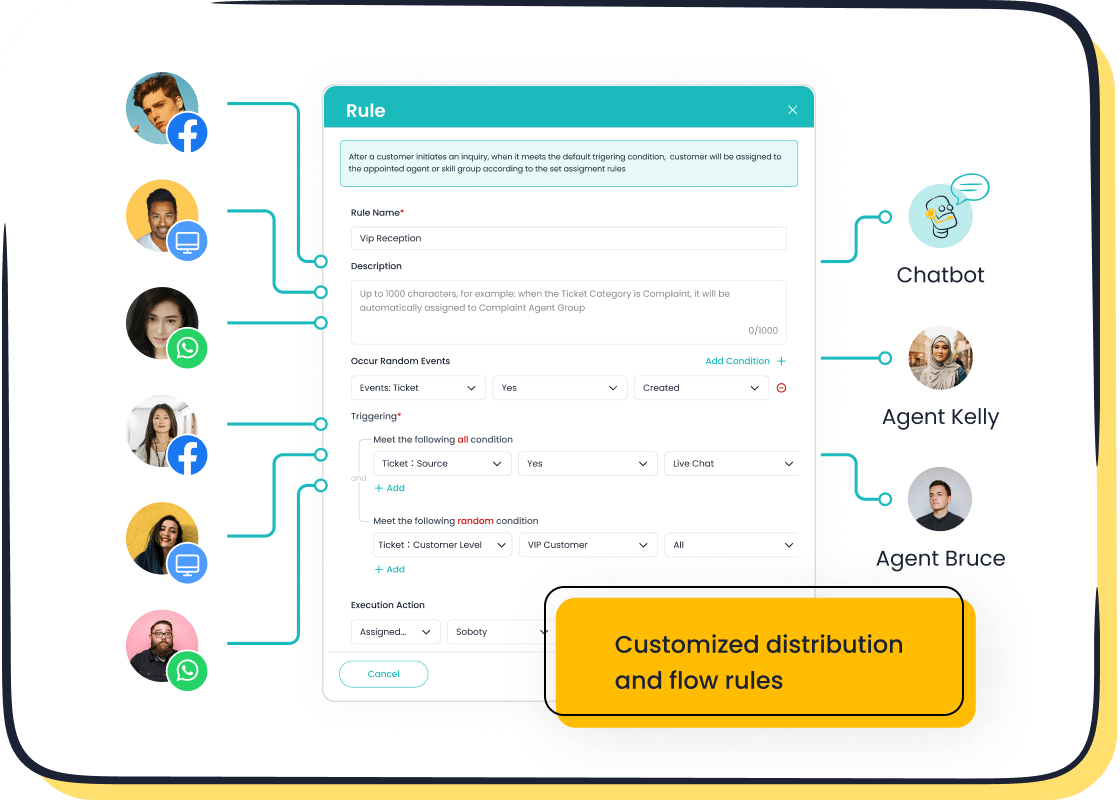
When you compare chatbots vs live chat for customer support, you find clear strengths and weaknesses. Many customers prefer live chat for its personal touch—63% say so, while chatbots offer instant, 24/7 replies and can cut costs by up to 30%. Some users get frustrated when chatbots miss context, but 74% like chatbots for simple questions. Sobot AI combines both options, letting you switch between automation and human help as your business needs change.
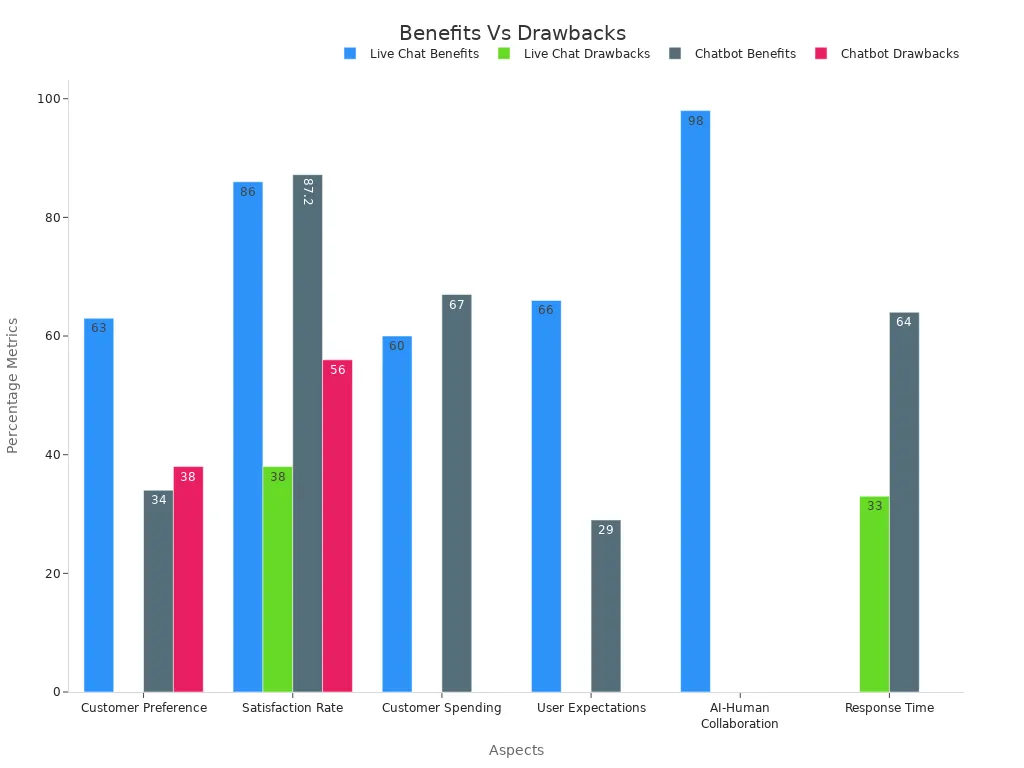
What Are Chatbots and Live Chat?

Chatbots Overview
You see chatbots everywhere in customer support today. A chatbot is a computer program that uses artificial intelligence to talk with customers and answer questions. Many companies use chatbots to help with simple tasks, like checking order status or answering common questions. Chatbots work 24/7, so you can get help any time, even at night or on weekends. Over 85% of businesses plan to use generative AI chatbots soon, and the chatbot market could reach $454.8 million by 2027. You find chatbots on websites, apps, and even on Facebook Messenger, which has over 300,000 chatbots.
| Statistic Description | Value/Insight |
|---|---|
| Businesses planning to use generative AI chatbots soon | 85% |
| Chatbot market revenue projection by 2027 | $454.8 million |
| Percentage of live chat communications handled by chatbots | 30% |
| Customers reporting positive chatbot experience | 80% |
| Consumers valuing 24/7 chatbot availability | 64% |
| Millennials relying on chatbots | 60% |
| Gen Z preferring chatbot first, then live human if needed | 20% |
| Number of chatbots on Facebook Messenger | Over 300,000 |
A good chatbot does more than just answer questions. It can handle many conversations at once, collect information, and even help you complete forms. Some important chatbot performance metrics include:
- Bot Experience Score: Shows how well the chatbot helps customers.
- Bot Automation Score: Measures how often the chatbot solves problems without a human.
- Positive Feedback Rate: Tells you how many users liked the chatbot’s answers.
- Conversation Length: Shows how long people talk to the chatbot.
Sobot’s AI-powered chatbot uses advanced technology to provide fast, accurate answers in many languages. It helps you automate customer support, reduce costs, and improve satisfaction.
Live Chat Overview
Live chat lets you talk to a real person online. You type your question, and a support agent answers in real time. Many people like live chat because it feels personal and quick. About 85% of customers say they are satisfied with live chat, and 79% of businesses see a positive impact on sales and loyalty. Live chat can handle up to six customers at once, and the average response time is just under three minutes.
| Statistic Description | Value/Insight |
|---|---|
| Customer satisfaction with live chat | 85% satisfied |
| Businesses reporting positive sales impact from live chat | 79% |
| Projected live chat market size by 2030 | $1.7 billion |
| Live chat simultaneous customer handling capacity | Up to 6 customers at a time |
| Preference among younger customers (18-34) for live chat | 56% prefer live chat over phone |
| Average response time to live chat message | 2 minutes 40 seconds |
| Businesses with 90%+ satisfaction had average wait time | 46 seconds |
| Increase in sign-up rate due to live chat | Up to 31% |
You get instant help with live chat, which makes it a favorite for many customers. Most people feel more comfortable using live chat than email or phone. Sobot Live Chat brings all your conversations into one place, supports many channels like WhatsApp and Facebook, and uses AI tools to help agents respond faster. This makes your customer support team more efficient and keeps your customers happy.
Tip: Combining chatbots and live chat gives you the best of both worlds—automation for simple tasks and human help for complex questions.
Key Differences
Automation vs Human Touch
When you look at the key differences between chatbots and live chat, automation stands out. A chatbot can handle many conversations at once. You never have to wait, even during busy times. In fact, chatbots provide instant replies, and 64% of customers say 24/7 support is their favorite feature. Live chat agents usually manage only two or three chats at a time. If you have a lot of customers, you need more staff to keep up. This makes chatbots much more scalable for high-volume support.
However, live chat gives you something a chatbot cannot fully match—empathy. Human agents listen, understand your feelings, and solve complex problems. They use emotional intelligence to build trust and loyalty. Automation works best for simple, repetitive questions. When you need a personal touch, live chat shines. Many companies use both. For example, Sobot’s platform lets chatbots handle routine tasks, while live chat agents step in for more complicated or sensitive issues. This blended approach keeps your support fast and friendly.
| Feature | Chatbots | Live Chat Agents |
|---|---|---|
| Response Time | Instant (0 seconds wait) | Average 45 seconds |
| Availability | 24/7, no time zone constraints | Limited to business hours unless multiple shifts are used |
| Multitasking Capacity | Handles many conversations simultaneously without extra cost | Typically 2-3 simultaneous chats per agent |
| Customer Satisfaction | 64% of customers value 24/7 support; 40% accept chatbots if fast | 55% of customers abandon sites if questions are not answered quickly |
Technology and Integration
Technology and integration also show clear differences between chatbots and live chat. A chatbot uses AI and machine learning to answer questions, collect data, and even understand different languages. When you connect a chatbot to your CRM, it can pull up your order history or preferences in real time. This makes your experience faster and more personal.
Live chat relies on human agents, but modern platforms like Sobot bring all your channels—website, WhatsApp, Facebook, and more—into one unified workspace. This means you never lose track of a conversation, no matter where it starts. Sobot’s omnichannel solution helps your team switch between chatbot and live chat smoothly. Agents see all customer data in one place, so they can give better answers and solve problems faster.
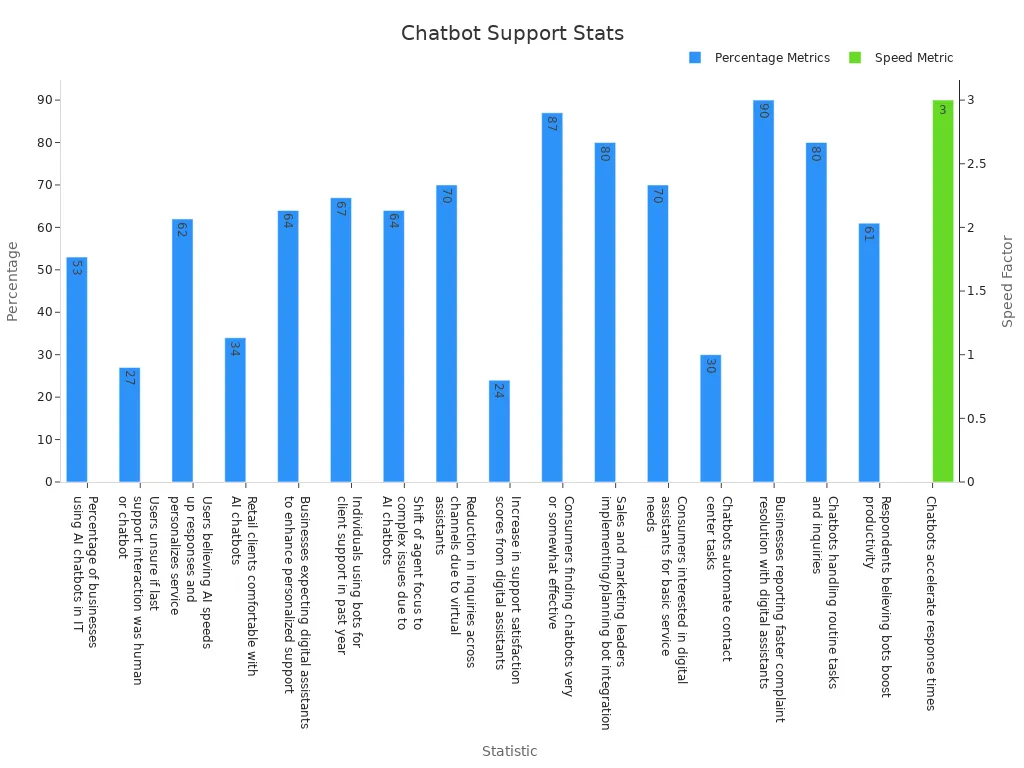
You get the best results when your support system combines both technologies. Chatbots automate routine tasks and speed up response times—up to three times faster. Live chat agents focus on complex or emotional issues. With Sobot, you can use analytics and AI to improve both chatbot and live chat performance, making your customer support smarter and more efficient.
Chatbots vs Live Chat in Customer Support
Response Time and Availability
When you compare chatbots vs live chat, speed and availability stand out. Chatbots respond instantly, no matter the time of day. You get answers in under five seconds, even at midnight or during holidays. This means you always have access to 24/7 customer service. Live chat support depends on human agents. Most live chat agents reply in about two minutes and forty seconds, but only during staffed hours. If you contact support outside business hours, you might wait longer or not get help at all.
| Feature | Chatbots | Live Chat |
|---|---|---|
| Response Time | Under 5 seconds | Average 2 minutes 40 seconds |
| Availability | 24/7 without breaks | Limited to staffed hours |
| Scalability | Unlimited simultaneous chats | Limited by agent capacity |
Sobot’s AI-powered chatbot gives you immediate answers, while Sobot Live Chat ensures you can reach a real person when needed. This combination helps you meet customer expectations for both speed and human connection.
Note: 66% of customers expect an immediate response, and 64% value 24/7 service as the best feature of chatbots. Source
Cost and Scalability
Cost and scalability are important when you choose between chatbots vs live chat. Chatbots handle thousands of conversations at once. You do not need to hire more staff as your business grows. This makes chatbots a cost-effective solution for high-volume customer support. Studies show that chatbots can reduce support costs by about 30% and deliver an average ROI of 200-800%. Cloud-based platforms like Sobot allow you to scale up easily, so you can serve more customers without extra costs.
Live chat support requires more agents as your customer base grows. Each agent can only manage a few chats at a time. This means higher staffing costs during busy periods. You also need to consider training and management expenses. Sobot Live Chat helps you manage these costs by using AI tools to boost agent efficiency and by integrating with your existing systems for smooth operations.
- Chatbots scale instantly to meet demand, with no extra hiring.
- Live chat support scales with more agents, which increases costs.
- Sobot’s unified workspace and analytics help you optimize both solutions for maximum efficiency.
Personalization and Experience
Personalization shapes the customer experience in every interaction. Chatbots use AI to remember your preferences and past questions. They can greet you by name and suggest answers based on your history. This creates a seamless and personalized customer service journey, especially for simple requests. Metrics like Net Promoter Score (NPS) and Customer Satisfaction Score (CSAT) help measure how well chatbots and live chat support meet your needs.
Live chat offers a deeper level of personalized service. A live chat agent can understand your emotions, ask follow-up questions, and adapt to your situation. This human touch builds trust and loyalty. Sobot Live Chat brings all your conversations and customer data into one place, so agents can see your full history and provide tailored support. This makes every chat feel unique and valued.
Tip: Use both chatbots and live chat to deliver a personalized customer service experience that adapts to each customer’s needs.
Complexity Handling
Handling complex issues is where chatbots vs live chat show clear differences. Chatbots excel at answering common questions and solving simple problems. They gather information quickly and can resolve up to 80% of routine inquiries. When a question is too complex, the chatbot can transfer you to a live chat agent for more detailed help.
Live chat support shines when you face complicated or sensitive issues. Human agents can understand context, show empathy, and solve multi-step problems. For example, Sobot’s hybrid approach lets chatbots handle basic tasks and escalate complex cases to skilled agents. This ensures you always get the right level of support.
- Chatbots: Best for FAQs, order tracking, and quick answers.
- Live chat: Best for complaints, technical issues, and emotional support.
- Sobot: Combines both for efficient and effective customer support.
Many companies, like OPPO, use Sobot’s hybrid model to boost efficiency and satisfaction. OPPO achieved an 83% chatbot resolution rate and a 94% positive feedback rate by letting chatbots handle routine questions and live agents manage complex ones.
Use Cases

When to Use Chatbots
You can use a chatbot when you want fast answers to simple questions. Many industries rely on chatbots to handle routine tasks and save time. For example, banks use chatbots to help with account questions, and travel companies use them for booking and ticketing. Chatbots work well when you need 24/7 support or when your team faces high volumes of requests. They also help reduce costs and improve response times. The table below shows how different companies use chatbots to boost results:
| Industry | Company | Chatbot Name | Use Case Description | Impact/Result |
|---|---|---|---|---|
| Fast Food | Domino's Pizza | Dom | Order tracking and placing orders | 15% increase in online orders |
| Finance | Bank of America | Erica | Account help and transactions | Over 17 million users |
| Travel | Amtrak | Julie | Ticket booking and customer queries | $1 million saved yearly |
| Retail | H&M | Fashion Bot | Outfit recommendations | 35% increase in engagement |
Chatbots help you cut ticket resolution time by up to 90%. Companies like Footshop reduced service costs by 33% with automation. You can rely on a chatbot for quick, transactional tasks and to keep your business running after hours.
When to Use Live Chat
Live chat works best when your customers need personal attention or face complex problems. You should use live chat if your business handles sensitive issues or needs to show empathy. Customers often get frustrated by long wait times or ineffective support. Live chat agents can solve these problems by giving fast, human responses. For example, 75% of people dislike waiting during transfers, so live chat helps reduce this frustration. When your support volume is low, live chat lets agents focus on each person and improve satisfaction.
| Factor | Live Chat Advantage |
|---|---|
| Complex Issues | Detailed explanations and empathy |
| Low Volume | Personalized support |
| Customer Expectations | Human touch and emotional connection |
| Wait Times | Faster transfers than call centers |
Hybrid Approach
A hybrid approach combines the strengths of chatbots and live chat. You let a chatbot handle simple questions and switch to a live agent for complex or emotional cases. This model gives you the speed of automation and the empathy of human support. Sobot’s hybrid solution helped OPPO manage high volumes during shopping festivals. OPPO’s chatbot resolved 83% of routine questions, while live agents handled the rest. This led to a 94% positive feedback rate and a 57% increase in repeat purchases. Studies show hybrid systems improve satisfaction and trust by offering both instant answers and human care. You can maximize efficiency and deliver a better customer experience with this balanced approach.
Tip: Use a hybrid model to meet customer needs at every stage, from quick answers to complex support.
Sobot Live Chat Advantages
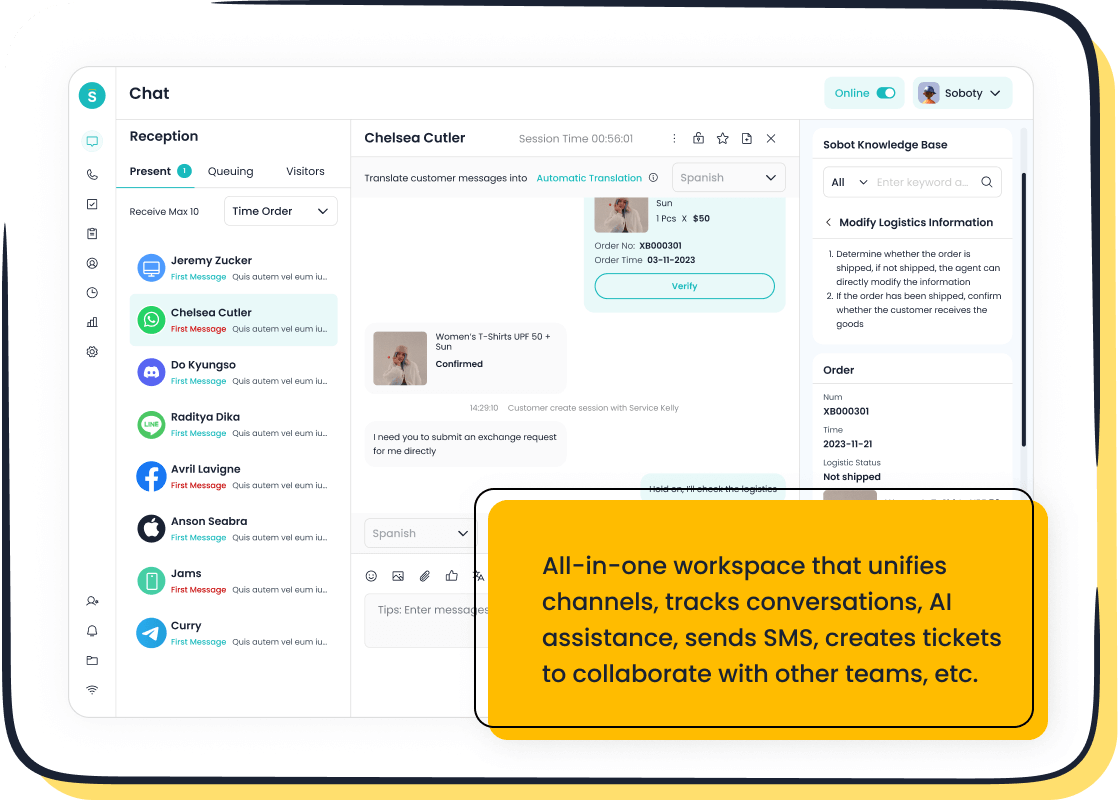
Omnichannel Support
You want your customers to reach you on any channel they prefer. Sobot Live Chat gives you true omnichannel support. You can connect with customers on your website, mobile app, WhatsApp, Facebook, Instagram, Telegram, and Discord—all in one place. This means you never miss a message, and your team can reply faster. Research shows that brands with strong omnichannel strategies see a 9.5% annual revenue increase, compared to just 3.4% for those with weak strategies. Customers who use three or more channels are 287% more likely to make a purchase. Sobot Live Chat helps you keep all conversations organized, so you can boost customer retention and drive more sales.
Omnichannel customers spend 30% more than single-channel shoppers, and businesses using omnichannel live chat support see higher customer retention rates—up to 89%.
AI-Powered Tools
Sobot Live Chat uses advanced AI tools to make your support smarter and faster. The platform’s AI can answer common questions, suggest replies, and even fill out tickets automatically. This reduces repetitive work for your agents and lets them focus on complex issues. The AI learns from every chat, so it gets better over time. You also get features like sentiment analysis, which helps you spot unhappy customers early. With Sobot’s AI-powered live chat, you can resolve over 60% of inquiries using the knowledge base, and AI voicebots handle more than half of customer interactions. Sales teams see a 30% improvement in results when using AI-driven outbound marketing.
| Metric / Feature | Description / Value |
|---|---|
| Resolution Rate | Over 60% with knowledge base support |
| AI Agent Handling Rate | AI voicebots handle 50%+ of interactions |
| Sales Improvement | 30% boost from AI-driven outbound marketing |
| Task Automation | AI reduces repetitive tasks, freeing agents for more important work |
| Omnichannel AI Support | Personalized, context-aware responses across chat, email, voice, and social media |
Analytics and Integration
You need to know how your support team is doing. Sobot Live Chat gives you a powerful analytics dashboard. You can track key metrics like resolution rate, customer satisfaction, and agent efficiency. The platform integrates with tools like WhatsApp Business API, Salesforce, and Shopify, making it easy to manage all your data in one place. After switching to Sobot, companies have seen response times drop by three hours and customer satisfaction rise by 25%. The system’s customization options let you tailor the experience to your brand’s needs, and its scalability supports your growth.
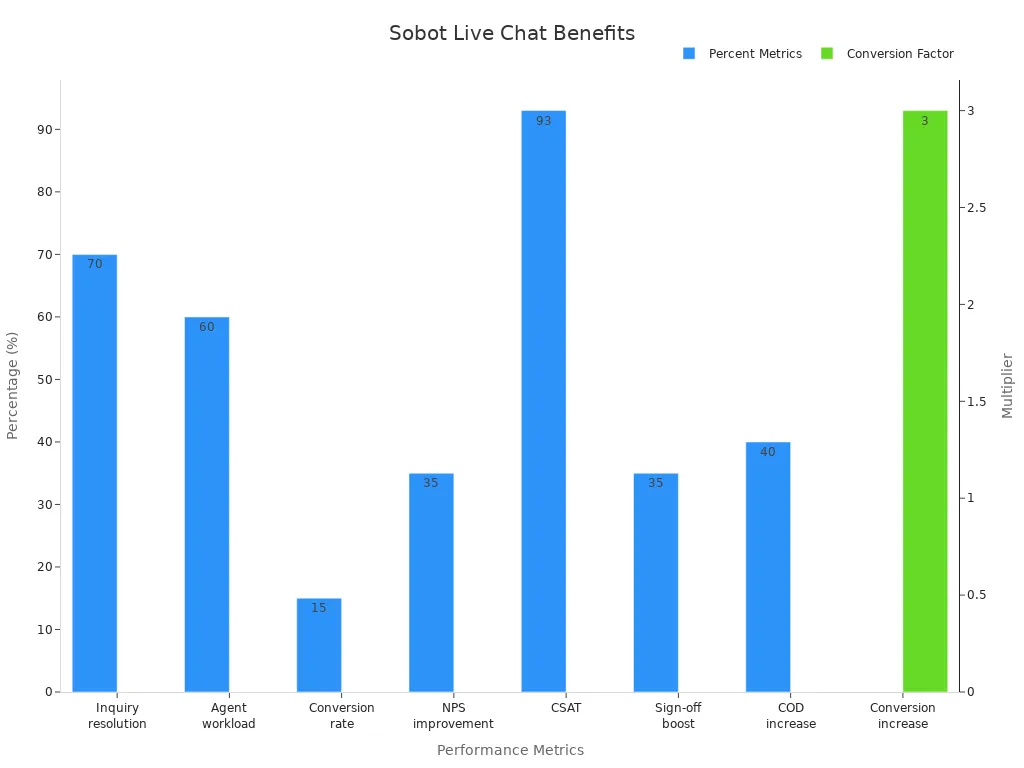
| Performance Advantage | Supporting Data / Metric |
|---|---|
| Inquiry resolution rate | 70% of inquiries resolved |
| Conversion increase | 3x (tripled conversions) |
| Agent workload reduction | 60% reduction in agent workload |
| Conversion rate improvement | 15% increase |
| Net Promoter Score (NPS) improvement | 35% increase |
| Resolution time | Under 1 minute via AI + human collaboration |
| Customer Satisfaction (CSAT) | OPPO achieved 93% CSAT |
Sobot Live Chat support helps you increase conversions, improve customer loyalty, and make your operations more efficient.
Choosing between chatbots and live chat for customer support depends on your goals and customer needs. Chatbots give you 24/7 support, cost savings, and fast answers for simple questions. Live chat offers real-time help and empathy for complex issues, but it costs more and is not always available. Many businesses use both to get the best results. Sobot’s hybrid solution lets you combine automation and human support for maximum efficiency. Review your support challenges and explore how Sobot can help you deliver better customer support.
| Aspect | Chatbots (Automated Support) | Live Chat (Human Support) |
|---|---|---|
| Availability | 24/7 support, instant responses | Limited to agent availability, not always 24/7 |
| Customer Experience | Efficient for simple/repetitive queries, less personalized | Personalized, empathetic, better for complex or nuanced issues |
| Efficiency | Handles multiple inquiries simultaneously, scalable | Effective for complex issues but resource-intensive |
| Cost | Cost-effective long-term, reduces need for human agents | Higher ongoing costs due to staffing and training |
| Integration | Integrates with CRM, ticketing, knowledge bases | Integrates with CRM, help desk, e-commerce platforms |
| Limitations | Struggles with complex queries, lacks empathy, may misinterpret slang or sarcasm | Potential for human error, limited availability, higher costs |
Tip: For the best customer support, consider a hybrid approach with Sobot’s chatbots and live chat. Learn more at Sobot.io.
FAQ
What is the main difference between chatbots vs live chat for customer support?
Chatbots use AI to answer questions instantly, while live chat connects you with a real person. Chatbots work 24/7 and handle many chats at once. Live chat gives you a personal touch and helps with complex issues.
When should you choose chatbots vs live chat?
You should use chatbots for simple, repetitive questions and 24/7 support. Choose live chat when your customers need empathy or face complex problems. Many businesses, like OPPO, use both for the best results.
How does Sobot support chatbots vs live chat?
Sobot offers both advanced chatbots and live chat in one platform. You can switch between automation and human help easily. Sobot’s hybrid approach helps you save costs and improve customer satisfaction.
Tip: Sobot’s omnichannel solution lets you manage chatbots vs live chat across websites, apps, and social media.
What are the cost benefits of chatbots vs live chat?
Chatbots can reduce support costs by up to 30% because they handle many chats at once without extra staff. Live chat costs more as your business grows. Sobot’s analytics help you track savings and improve efficiency. Source
See Also
Advantages of Using Live Chat Over Traditional Email Support
Expert Techniques To Excel At Live Chat Support
Best Live Chat Platforms Reviewed And Ranked For 2024
